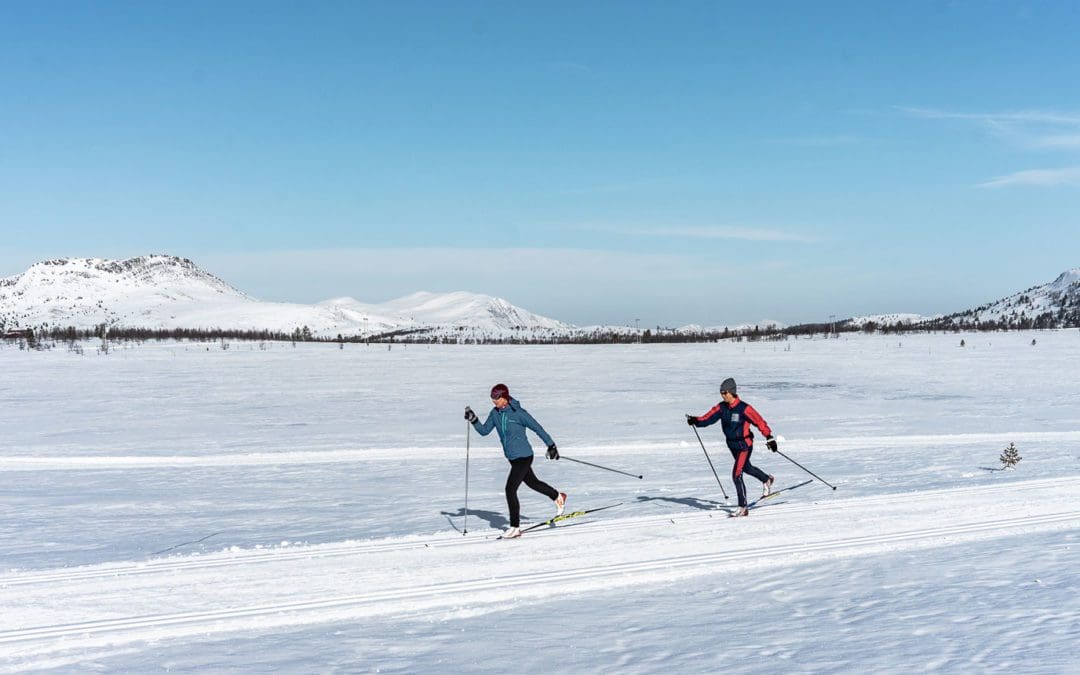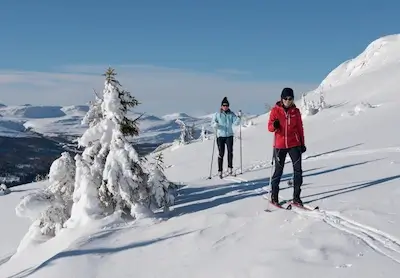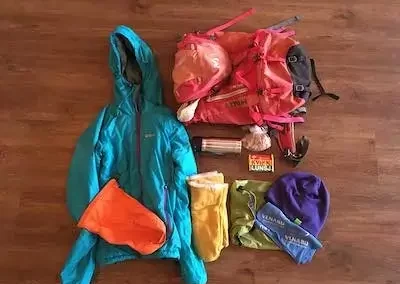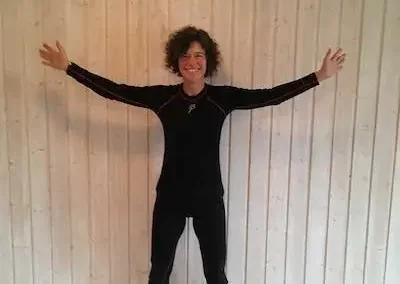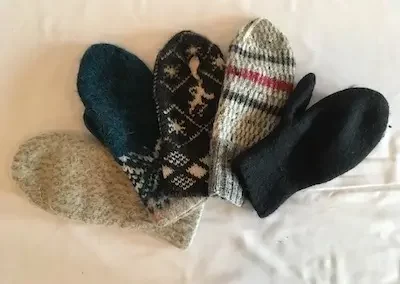What to wear for cross country skiing?
Are there any particular things we should think about when getting ready for a cross country skiing holiday in Norway? These are excellent questions which I hope to answer here, in this and subsequent posts.
Being comfortable while active and warm enough during breaks
We want to be comfortable while we are skiing – in terms of temperature and freedom of movement, and know that we will be warm enough when we stop for photos or to have a snack. This does give us something to think about because the air temperatures can be low and yet we are active, generating heat. This means that we heat up while we’re moving and can cool down rapidly when we stop.
As ski guides we often see people who have rightly anticipated cold weather but have brought lots of very warm clothing, without much flexibility to adjust for being active. Overdressing like this, without the option of adjusting layers, can lead to a cycle of overheating and getting cold. In addition, skiing with a group may mean that you stop at different times than you would when skiing with a friend so, again, flexibility is key.
Ski specfic clothes or outdoor clothes?
The good news is that if you are an active person and spend time outdoors walking or doing other sports you may already own suitable clothes. For some items cross country ski-specific clothes are a good investment and I’ll highlight those in this article.
This is a subject that I could write a lot about! There will also be a follow up article with specific clothing tips and tricks for cross country skiing.
What to wear in a nutshell:
- Wearing layers and carrying a rucsac almost covers it all

- Over-dressing can lead to over-heating and then getting cold – a rucsac allows you to be flexible with layers
- Wicking base layers work – we love wool!
- Think about having a choice of mid layers
- Cotton next to the skin can mean a damp layer that makes you chilly
- Shell jacket – windproof/waterproof, breathable, hoods are useful
- Outdoor activity trousers – windproof, breathable
- Gloves – it’s worth carrying a spare pair if you get cold hands or will be out for more than a couple of hours
- Protect your eyes and ears – wear sunglasses and take a hat
- Buffs are super-versatile for cross country skiing
- Carrying a ‘duvet’ jacket is a good idea
- Dry bags work well for keeping your things dry in your rucsac
- Alpine ski goggles are best avoided for most conditions
- Did I mention layers? And a rucsac…
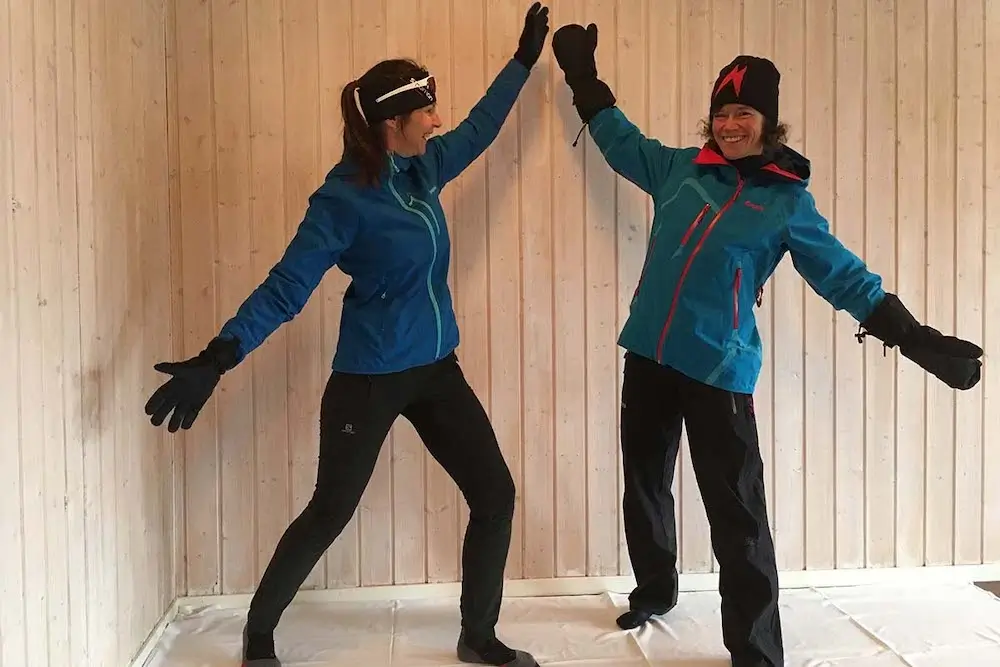
What to wear, in more detail…
What you choose to wear for cross country skiing will depend on a few different factors including:
- the weather conditions,
- the tour you plan to do
- how you are feeling that day
For longer days and mountain tours looser clothing is more suitable as it tends to be warmer because it traps more air. Closer-fitting, athletic clothing suits shorter ski tours, without much stopping.
In the large photo above we Wenche (right) is wearing looser ski clothing, as we would on our Ski Safari off track tours and the tours on our Classic Cross Country Ski Holiday. Joy (left) is wearing ski clothes more suited to an athletic style of skiing, for example during our Become a Better Skier course. On a course, Joy would also have a rucsac with her to keep a spare warm layer, a drink and a snack.
Temperatures
Temperatures around -10°C are considered perfect for cross country skiing. This sounds cold, however, for most of the winter in Norway it is a “dry” cold which, from experience, tends to feel less cold than “damp” cold.
We may have temperatures below -10°C and similar guidelines apply. On the odd occasion of temperatures being very low then we adapt the tours.
About over-dressing again…
As I mentioned above flexibility is key and so carrying a rucsac with enough room to stow spare layers can make a big difference to how much you enjoy your day. Your rucsac also gives you easy access to a warm drink and a snack. We make sure that there’s always time on tours for guests to adjust their layers and have a drink.
We recommend that guests don’t plan to ski in thick, padded alpine ski jackets or trousers. These are designed to keep you warm while sitting on a chair lift or on a restaurant terrace. An insulating duvet jacket layer will keep you warm when stopping or if it’s really cold. Duvet jackets that are also known as “belay jackets” are ideal. They are designed to be light and pack down well into your rucsac.
So, back to layers:
Base layer
A base layer, top and bottom plus socks, in a breathable, wicking fabric will help to keep you dry and comfortable even if you are working hard. Wool makes a great base layer and finely spun merino wool is a great choice.
When packing for your holiday it may be worth bringing socks of different thickness to help you get the best fit in your hire boots.
There are so many options now, which base layer should I choose?
In choosing a fabric and the thickness of your base layers consider how much you heat up while exercising. Ok, I’m going to say it: think about how sweaty you get. This varies person to person. At the risk of TMI, I get really hot when I’m exercising and then cool down quickly and feel cold. I choose thin base layers, except for the coldest days or when I know I won’t be working so hard. I can then regulate with layers on top.
If you choose a synthetic fabric, from personal experience, I’d avoid those that look too ‘shiny’ as I have found that these are more likely to stay damp. Synthetic base layers last a looooong time/are almost indestructible. After a while, even with frequent washing, they can smell.
Mid layers
Wool or fleece mid layer (s). Thinner layers that can be, well, layered, are more flexible. They are also easier to pack away in your rucsac than one big warm jumper or fleece.
Windproof, breathable outer jacket
On days that are very snowy or windy a hood really is a necessity, so a waterproof, breathable shell jacket can be a good all round choice.
If you do a lot of cross country skiing or like to have more clothing options, this is where a cross country ski jacket can serve you well. These jackets are typically made of ‘soft shell’ fabric. Alternatively bring a windproof, breathable cycling/running/hiking jacket. Ideally – one that you can fit layers underneath but, if this is all that you have, you will miss a hood in bad weather.
Trousers
A pair of winter-weight outdoor trousers made from a ‘soft shell’ fabric can be ideal. Again a pair of cross country ski pants may be a good investment. They are designed for the activity and stretch so you can move. They usually have windproofing and they are breathable.
However, for guiding, my favourite trousers are a pair of soft shell outdoor trousers. Mine are Goretex softshell and are loose fitting (trap more air with a base layer). They keep me dry and warm, plus they are breathable and well worth the investment – I’m outdoors every day.
Quite a few manufacturers now make good quality, breathable membrane soft shell fabrics.
Unfortunately cheaper, plastic, non-breathable over trousers aren’t a great everyday choice. However, lightweight waterproof overtrousers (designed for active wear – think running, cycling or hiking) are great to have in your rucsac when snow is forecast or if it’s windy.
Carrying waterproof over trousers, in case of bad weather or as a light extra layer, is recommended on more remote day tours such as the Ski Safaris.
Hat, gloves/mitts, buff
These are essentials – for protecting our ears in cold weather and keeping warm. We lose a lot of heat through our heads. Wearing a hat is also one of the quickest ways to regulate our temperature. A hat stuffs into a pocket so you can adjust your temperature without needing to take off your rucsac.
Headbands (for men and women) in the warmer weeks keep your ears protected but limit overheating. Maybe it’s time to embrace the fat headband look!
Gloves or mitts?
Essential kit. Cross country ski gloves work well when it’s not too cold (be aware that they are sold for different seasons: winter and spring). If you suffer from cold hands you may prefer mitts when its cold.
I get cold hands but I don’t like mitts for skiing unless it is very cold. I wear a thin pair of merino gloves, which are long and extend well above my wrists (great design) plus a pair of ‘lobster claw’ mitts which are half way between gloves and mitts, an excellent combination.
Carrying a second pair of gloves in your rucsac is a good idea (and possibly more pairs on a long day tour). Wet gloves/mitts feel really cold, so changing to a dry pair can make a big diference to how comfortable you feel.
Hand warmers are a good back up if you know your hands get cold.
Buff
A really useful piece of clothing! Having something around your neck helps to keep you warm and the drafts out. Again taking a buff off is an easy way to cool down without needing to get into your rucsac.
Buffs can be worn as an extra hat or to make a balaclava when it’s really cold. See the article on ‘Top Tips’, coming soon.
‘Duvet’ jacket
Synthetic or down (some manufacturers also produce duvet jackets with a wool fill) with a Pertex-type shell are lightweight and pack down. For cold, dry weather down jackets are great.
More about choosing a duvet jacket in the ‘Top Tips on Clothing’ article, to be published soon.
Rucsac
A 25–30 litre rucsac will allow you to swap your layers as you choose. There’s room for a small flask and snack, phone, spare clothes (those layers), tissues, waterproof over trousers plus other necessities.
We recommend that everyone carries a rucsac so that you can get to your things when you need to rather than hailing a partner who may be a distance away on the track.
Rucsacs don’t need to fill up or be heavy. Your guides will be carrying a group first aid kit and emergency items.
Other things to carry, wear or pack:
- A warm drink and a snack
I’d say having a snack with you is also an essential. The chances are that you will be working consistently, if not hard, for a few hours. That means that most people need to take on some extra calories. We are all different but the feeling of ‘bonking’ or running out of energy, even half an hour away from the hotel is a horrible one. You may not feel hungry but still need to take on calories. Guests who don’t exercise regularly at the same intensity or duration as cross country skiing may not recognise when they need to eat something. Even exprienced atheletes can get this wrong and having a snack handy makes everything much simpler. Having a high calory snack can also help you to stay warm. - Sunglasses, sunscreen
It’s important to protect our eys, even on a low light day, there is a lot of UV with light reflected off the snow.
In foggy conditions you may be surprised to see how dark “reactalite” type lenses become – indicating how much UV there is. - A lip balm with sun protection is nice to have in your pocket.
- It may be worth bringing your favourite foot care items with you on holiday such as moleskin or Compeed, just in case.
Fabrics
Any fabric has its pros and cons. With growing awareness of micro plastics many people choose to avoid/limit synthetic clothing.
Wool is making a great comeback, and in Norway it has never gone away.
Cotton is best avoided in any layer except perhaps a ‘Ventile’ style cotton outer shell, more about that in the ‘Clothing Top Tips’ article to follow. Cotton tends to stay damp and then feels cold, especially next to the skin. Wearing cotton for outdoor activities has been associated with many cases of hypothermia.
A couple of tips on taking care of your outdoor clothing:
- Don’t use fabric conditioner on Merino wool.
- Be careful with tumble-drying, many outdoor clothes don’t like it, check the care labels.
- Waterproof shell clothing can be re-proofed with wash-in or spray-on products such as those made by Grangers or Nikwax.
I hope this article has been useful. It is the first in a series of blogs that we hope will be informative.
“Excellent guiding team!”
“An amazing week. The whole guiding team was excellent and very patient for me as a beginner. Music in the evening and a relaxed, friendly atmosphere. Hope to be back soon.”
Josephine (UK)
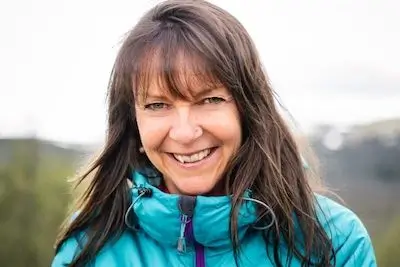
Joy O’Flanagan is an experienced BASI Nordic Ski Instructor and International Mountain Leader. She is also a movement specialist: a qualified physiotherapist and Pilates instructor.

